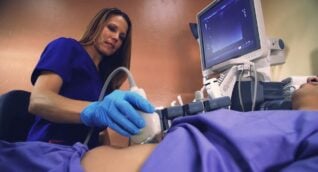Thyroid ultrasound is an imaging technique that uses sound waves to evaluate abnormalities of the thyroid gland. The thyroid is an endocrine organ located in your neck in front of your trachea (“wind pipe”). Hormones produced by the thyroid gland help regulate your heart rate, body weight, and other metabolic functions. Ultrasound assists doctors in evaluating thyroid nodules, enlargement, or inflammation. This test is non-invasive and does not expose the patient to ionizing radiation (X-rays). Thyroid ultrasound uses a specially-designed transducer (probe).
Five to 10 percent of adults may develop a lump in their thyroid gland detectable by a doctor’s physical exam. Up to 70 percent of adults have thyroid nodules detectable by ultrasound. Even though most of these nodules are benign (non-cancerous), ultrasound helps doctors evaluate which thyroid nodules might be malignant (cancerous).
More basic information on ultrasound is available on our About Ultrasound page.
Thyroid ultrasound is an effective way to evaluate thyroid abnormalities. The exam is especially useful in differentiating between solid and fluid-filled nodules. Nodules filled with fluid (cysts) are less likely to be cancerous. Thyroid ultrasound is recommended to:
- Identify the size and consistency of a thyroid nodule.
- Determine if a thyroid nodule should be biopsied.
- Assess the growth of thyroid nodules.
- Locate other nodules that may not be detected by physical exam.
Since the images can be produced in real time, thyroid ultrasound can also guide doctors in taking biopsies of any nodules to test for malignancy.
Benefits
- Thyroid ultrasound is an inexpensive, fast, and non-invasive way to assess the thyroid gland. The test helps determine whether a thyroid nodule should be biopsied to determine if cancer cells are present.
- Ultrasound does not expose you to any ionizing radiation (X-rays).
- Unlike MRI, ultrasound can be used in patients with any type of metal in their body, including implantable medical devices.
- Ultrasound is very safe and has no side effects.
- There is no need to take contrast for ultrasound exams.
- Ultrasound can detect soft tissue abnormalities that cannot be visualized with regular X-ray exams.
Risks
- The use of diagnostic ultrasound (without biopsy) has no known risks or harmful effects.
- Thyroid ultrasound is done in an ARA imaging center. The exam will take about 30 minutes and you will be in the imaging center for about an hour.
- You may be asked to change into a gown.
- You will be placed lying on your back on an exam table. You may need to change position during the exam.
- A water-based gel will be placed on your neck where the thyroid gland is located. The gel creates a sealed contact between your skin and the ultrasound probe. This eliminates any air pockets that may interfere with imaging. The probe will be moved around to capture images from different locations. The gel does not stain clothing.
- The technologist or doctor performing the study may have to apply pressure with the probe to the body part being examined. If the area is tender, you may experience some discomfort.
- You can return to your normal activities after the exam is over.
Wear comfortable, loose-fitting clothing for the exam. Otherwise, no special preparation is required for thyroid ultrasound.
To schedule a thyroid ultrasound, please use our online scheduling tool in the Patient Portal or you may call our scheduling team at (512) 453-6100 or toll free at (800) 998-8214. A referral from your healthcare provider is required to make an appointment.
A radiologist, a physician specifically trained to interpret radiological examinations, will analyze the images and send a signed report to the provider who referred you to ARA. The physician will then share the results with you.

